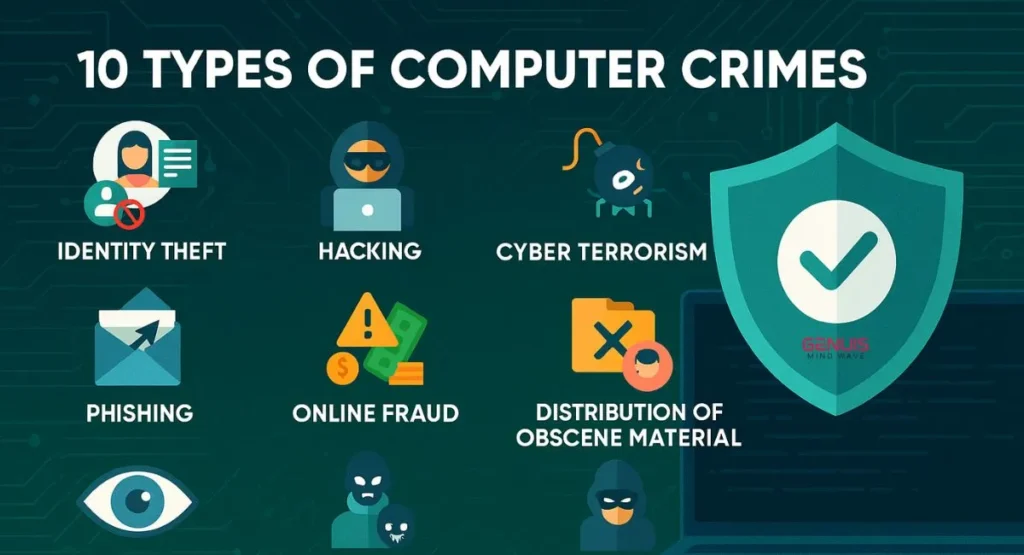What are the 10 types of computer crimes? You may be at risk from these crimes while using your phone or laptop. Computer crimes are on the rise and can happen to anyone. This article will tell you what computer crimes are, how to prevent them, and who commits them. Most crucially, learn to safeguard yourself against the 10 prevalent forms of computer crime.
There are various types of computer crimes and strategies to avoid them.
In this digital world, knowing about the 10 types of computer crimes is more important than ever. There are more and more of these crimes, which touch everyone, from small businesses to regular people.
This article tells you about these crimes, who commits them, why they happen, and, most importantly, how to keep your personal information safe online.
What Is Cybercrime
Cybercrime is when you use a computer, the internet, or a network to break the law. It could be stealing money, letting private information get out, or shutting down services to make people suffer.
These acts can harm individuals like you and me, not just large corporations. Occasionally, these acts involve the use of fake texts. At other times, these acts include hacking into government servers in complicated ways.
How Does It Involve Computers?
These acts typically involve the use of computers, phones, and tablets. Crimes are committed against them, plans for crimes are made, and people help each other commit illegal acts. This is why simply breaking into computers is no longer sufficient. Technology can also change things that happen in the real world.
Cybercrime is awful since it can hurt people, businesses, and even whole nations. You risk losing clients’ trust, stealing their money, or causing the system to malfunction.
Police frequently examine electronics to determine whether they were part of a hack or the intended target. This is true whether someone steals your name or puts a company out of business.
Who Commits Computer Crimes?
Cybercrime can take many forms; for example,
Hackers,
Scammers,
Some are frustrated workers who want to hurt the company.
Some use their skills for good, such as white hat hackers.
Others, called black hat hackers, try to commit cybercrime activities against organizations.
One thing is clear: not all cybercriminals are technical experts.
Why Are Computer Crimes on the Rise?
Tech is important because it always makes it possible for new things to happen. Many smart devices can connect to the internet. There are both good and bad effects that can happen.
A significant risk is inadequate security measures and practices to protect these technologies.
The incidence of cybercrimes is increasing rapidly.
In cyberspace, people can quickly connect to another computer network.
Different countries may have different laws regarding cybercrime.
How many types of computer crimes are there?
There are two main ways computer crimes happen.
One is by directly attacking computers. The other person is utilizing computers to help them conduct further crimes.
Understanding both helps you see how dangerous these threats can be and why network security matters.
Two Main Categories of Computer Crimes
Targeting Computers
This includes attacks that go straight after devices or systems. Examples are ransomware attacks, viruses, or denial-of-service attacks that overload servers.
These attacks can lock files, slow down networks, or destroy data.
Malicious software, such as worms or spyware infections, typically executes these attacks.
Using Computers
In this category, computers are tools used to help commit crimes. This includes scams, fake job offers, or spreading lies online.
Even simple things like sending fake emails fall under this type. It shows how easily someone can misuse technology.
10 Common Types of Computer Crimes You Must Know
Here are 10 Types of Computer Crimes.
1. Phishing and Scams
Anyone can send a fake message to get your credit card or login information. We refer to this as phishing.
Thieves sent these texts, which appear genuine. This is a form of manipulation to get people to give up private information.
Your bank may send you an email telling you to log in quickly. Before you click on any link, make sure you know who sent it.
2. Identity Theft
Someone takes your name, Social Security number, or any of your information and uses it against you. This type of attack is called identity theft.
They could start new accounts, buy things, or even file their taxes in your name.
This is a type of data breach that can take months to fix. This is why it is important to keep private data safe.
3. Ransomware Attacks
It’s not a given that you will get your info back, even if you pay. There is a lot of worry about this kind of cyberattack in the United States, especially in schools, hospitals, and local governments.
It gets on your device when you go to dangerous websites, open harmful emails, or use software that hasn’t been updated with the latest security patches.
4. Hacking Networks
Hacking means getting into private systems without being allowed to. Once they get in, they can steal data, delete files, or watch people.
Bugs like these are often used to break into large companies or government agencies.
Insider danger occurs when an employee with access engages in actions that could potentially harm others.
5. Internet Fraud
Any online lie or trick, such as dating scams and fake shopping sites, is known as internet fraud.
This type of fraud frequently occurs on dating apps and online marketplaces, where individuals tend to trust one another too quickly.
Before transferring money online, please ensure you have verified the recipient’s identity.
6. Cyberbullying
A cyberbully is someone who uses the internet to harm or threaten another person, especially by sending them unpleasant messages.
This is especially common among young people. It can cause emotional pain or depression.
Parents should monitor their children’s online activities and educate them on the importance of online safety.
7. Cyberstalking
Cyberstalking involves repeatedly contacting someone inappropriately. The purpose is simply to intimidate, threaten, or control. It involves sending threats or messages. It can include displaying a fake profile or sharing inappropriate photos without consent. The act is a serious crime that can lead to legal action.
8. Software Piracy
Software piracy is another big problem for the whole software industry. It means that someone copies software from a software company or software developer and starts selling it without asking for permission. Doing so is against the Software Copyright Act. If someone steals software or simply copies it without permission, uses it, and sells it, then legal action can be taken against them.
9. Social Media Fraud
Social media fraud includes fake accounts, mimicry, or spreading fake news online.
One can use it to deceive friends or disseminate misleading information.
To avoid falling victim, always double-check profiles and enable strong password practices.
10. Online Recruitment Fraud
This form of fraud is also a common scheme that spreads throughout society. In this scheme, criminals post fake job listings to obtain your personal information or money. They might request sensitive information, such as your Social Security number, or demand payment in exchange. Always research the company first to make sure it is trustworthy. Only then proceed with your procedure.
How to Prevent Computer Crimes
Prevention is better than a cure. Here are six steps to help you avoid being a victim.
Each step plays a role in improving your information security and reducing risk.
1. Keep Your Software Updated
Regularly update your computers, phones, and antivirus software to protect against cyber threats. Enable auto-updates where possible. This process is one of the easiest ways to reduce system vulnerabilities.
Outdated software has vulnerabilities. Hackers can exploit them.
Old systems and outdated software are prone to open doors, making it easy for criminals to get in.
2. Use Strong Passwords
Create a strong password. Create a password with a mix of numbers, letters, and symbols, without using common words or personal details like your name or birthday date.
Use a password manager to keep track of complex passwords across multiple sites.
Never reuse the same password for different accounts—it increases your risk of password theft.
3. Be Careful With Emails and Links
Suspicious emails, messages, or pop-up ads may contain viruses or phishing scams. Avoid clicking such links.
Don’t download unknown attachments. These are common phishing scam tactics.
Check the sender’s email address carefully. If something looks off, delete the message.
Remember, many cyberattacks start with a single click.
4. Install Antivirus and Firewalls
Good antivirus software blocks malware and viruses. Firewalls act as a shield between your device and the internet. Make sure both are active and updated regularly.
They may not stop every attack, but they add layers of firewall protection that make it harder
for hackers.
5. Back Up Your Data Regularly
If you get hit by ransomware, backups can help you get your files back. Use cloud storage or an external drive.
Obey the 3-2-1 rule:
– 3 copies of your data
– 2 different storage types
– 1 copy stored offsite
This helps ensure your data stays safe even during a major breach.
6. Educate Yourself and Others
Stay informed about the latest threats. Teach kids and coworkers how to stay safe online.
Take free courses like the Google Cybersecurity Certificate to strengthen your cybersecurity skills.
Knowledge is your best defense against real-world cyber threats.
7. Enable two-factor authentication (2FA)
To make your security even better, turn on 2FA. If someone gets the password, they cannot log in without the second verification step.
8. Secure Wi-Fi network
A strong password should be set for the home Wi-Fi to prevent hackers from accessing the internet connection.
9. Log out of public devices
When using a public computer or someone else’s phone, always log out of your accounts after use.
10. Shop only on trusted websites
While shopping online, use a well-known website with secure payment options. Check the website’s URL to ensure it begins with “https://.”
11. Do not share personal information online
Sensitive details like bank account numbers and passwords should not be shared on social media or unknown websites.
12. Report suspicious activity
Please promptly report any instances of fraud, hacking, or online threats to the cybercrime authorities or the police.
Final Thoughts
Computer crimes are real, and they’re increasing every day. From phishing to ransomware, the risks are high, but so are the ways to prevent them.
You can protect yourself and your loved ones by understanding the 10 types of computer crimes and taking simple steps like updating software and using strong passwords.
Stay alert. Stay informed. And above all—stay safe online.


